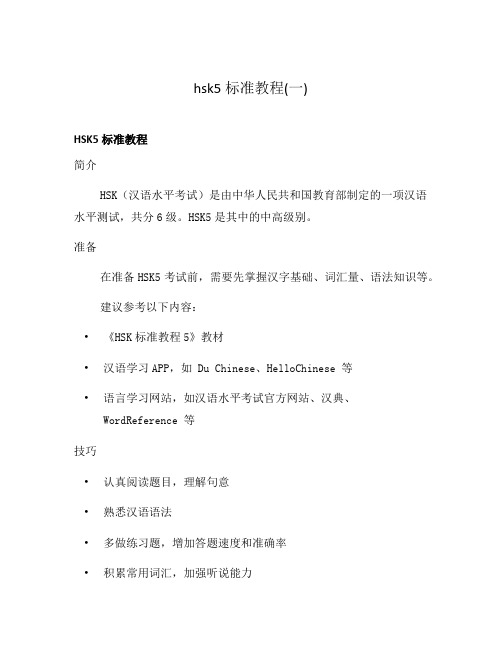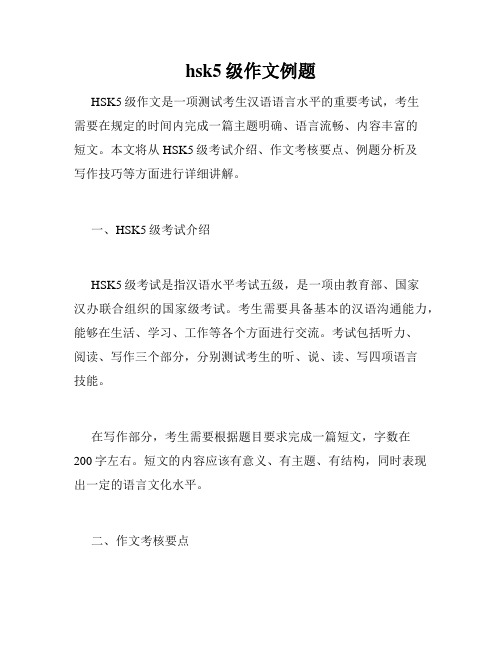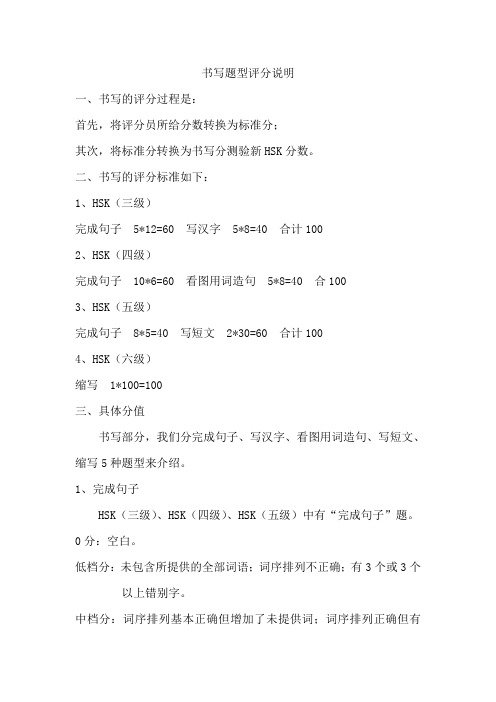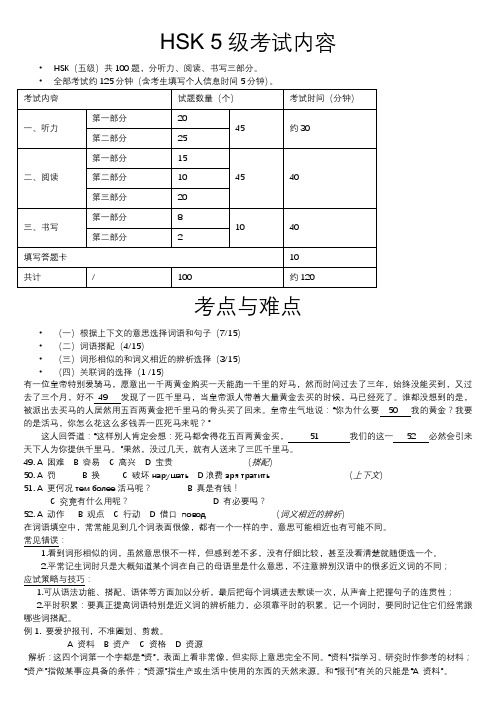HSK5级 书写讲解
新HSK五级写作-详全

新HSK五级写作一、新HSK五级写作的第二部分的第一题提供几个词语,要求考生用这几个词语写一篇80字左右的短文。
下面我们结合新HSK五级写作的一个实例来讲解如何根据提供的词语写短文。
【实例】请结合下列词语(要全部使用),写一篇80字左右的短文。
俱乐部教练胡同平均收获解题步骤:1、根据所给的词语确定主题。
根据上面的五个词语我们可确定主题为:我参加乒乓球俱乐部收获很大。
2、根据自己确定的主题,用每个词造句。
俱乐部:我参加了一个乒乓球俱乐部。
胡同:这家俱乐部在我住的那条胡同里。
教练:这里有乒乓球教练。
平均:参加俱乐部平均每个月花50元钱。
收获:我的收获非常大。
3、在造出的句子间添加关联词。
我参加了一个乒乓球俱乐部,这家俱乐部就在我住的那条胡同里。
这里不仅有乒乓球教练,还有很多热爱运动的朋友。
参加俱乐部平均每个月花50元钱,但我的收获非常大。
4、修饰,润色。
我参加了一个乒乓球俱乐部,这家俱乐部就在我住的那条胡同里。
这里不仅有专业的乒乓球教练,还有很多热爱这项运动的朋友。
参加俱乐部的费用很低,平均每个月只需花50元钱,但我的收获非常大。
不仅锻炼了身体,还交了很多好朋友。
二、新HSK五级写作的第二部分的第二题是提供一张图片,要求考生结合图片写一篇80字左右的短文。
下面我们结合新HSK五级写作的一个实例来讲解如何看图写作。
【实例】请结合这张图片写一篇80字左右的短文。
解题步骤:1、仔细地观察图上的画面,看清图上画的是发生在什么时间、什么地方的事。
从图上两个男青年(更准确的应该是两个好朋友吧)在一起用电脑,背景是窗帘、沙发,很肯定的是家里的摆设,所以我们定下作文的时间和事件:两个朋友在家里一起用电脑。
2、画面上有哪些人、哪些景和哪些物?注意观察人的服饰、容貌、年龄、身份、表情、动作,并给主要人物取名。
画面上有两个人,两个男人都着便装,他们对着电脑屏幕在一起讨论,很随意地坐在沙发的前边,脸上是愉悦的表情。
3、合理想象。
HSK5级书写部分第三讲

HSK5级第三套真题
91.蔬菜 채소
“是”表示事物等于什么或属于什么。 鲁迅是伟大的作家。(等于) 狗是犬科动物。(属于) 土豆范围小,蔬菜范围大。 答案: 土豆‖【也】是 ︳一种蔬菜。
92. ﹙那个﹚花盆‖【被】打〈碎〉了。
“被”介词,用于被动句。 主语+“被+N/代词”+谓语 “被+N/代词”做状语。 “被”字句一般叙述已经实现的事实。 基本句型:S+被+N+V+其他成分 比如:我的小秘密终于被他发现了。 句型2:S+被+V+其他成分 比如:做公共汽车的时候,我的钱包被偷了。 今天我出门没带伞,全身都被淋湿了。
为/为了的区别:
“为”多用于书面语,“为了”多用于口语。 “为”可放于句首,也可放于句中,“为了” 多放于句首做状语 “为”前可用“不”,“为了”不可以。 “为”可以表示原因,可以表示目的,“为了” 表示目的 “为”可以用“给”或“替”替换。
“了”的用法
1.“了”用在动词后,表示动作已完成。 结构:V+了 V+了+O 我买了三张票。 我做完了作业。
“地”用在状语后面, 比如:声音渐渐地小了。 他猛地一回头。
“得”用在补语前面 比如:那阵雨来得猛,去得快。 他高兴的眼泪都流出来了。
进行,V,做谓语,前可以有状语,后可以有 补语, “得”补语标志 相当,adv,和格外、非常、很一样,表程度。 “相当”后可加“地”做状语,如:这件事情 办得相当地好。
hsk5标准教程(一)

hsk5标准教程(一)HSK5标准教程简介HSK(汉语水平考试)是由中华人民共和国教育部制定的一项汉语水平测试,共分6级。
HSK5是其中的中高级别。
准备在准备HSK5考试前,需要先掌握汉字基础、词汇量、语法知识等。
建议参考以下内容:•《HSK标准教程5》教材•汉语学习APP,如 Du Chinese、HelloChinese 等•语言学习网站,如汉语水平考试官方网站、汉典、WordReference 等技巧•认真阅读题目,理解句意•熟悉汉语语法•多做练习题,增加答题速度和准确率•积累常用词汇,加强听说能力•注意时间分配,不要过分耽搁于某一题目考试内容词汇HSK5词汇量要求达到2500个,包括基础词汇和扩展词汇。
常见考点有:•同义词、反义词•动宾短语•四字熟语等语法HSK5语法要求掌握相对复杂的句式和语法知识,常见考点有:•趋势补语•独立主格结构•前后句衔接等阅读HSK5阅读要求阅读难度较高的文章或文段,对语言表达细节、含义等进行深入理解和分析。
常见考点有:•短文阅读•文章主题•排序等听力HSK5听力测试考察听取较长的对话、独白,理解其主要内容、内涵和涉及的信息。
常见考点有:•短对话•长对话•短文投影等写作HSK5写作要求能够用汉语表达一些复杂的思想和语言细节,常见考点有:•作文•书信•日记等总结通过上述内容的学习,可以为备考HSK5提供一定的指导和帮助。
记得在备考过程中合理分配时间,多做练习题和模拟考试,掌握应试技巧。
祝各位考生取得优异的成绩!模拟题目以下是几道HSK5考试的模拟题目。
词汇部分1.下列词语中属于动宾短语的是:A. 坐飞机B. 做梦C. 看电影D. 喝水2.下列词语中属于同义词的是:A. 牛仔裤、裤子B. 做饭、烧菜C. 漂亮、美丽D. 学生、学员语法部分3.下列句子中属于独立主格结构的是:A. 他看了一本有趣的小说,心情很舒畅。
B. 李老师发现学生们的进步很明显,她高兴得合不拢嘴。
hsk5级作文例题

hsk5级作文例题HSK5级作文是一项测试考生汉语语言水平的重要考试,考生需要在规定的时间内完成一篇主题明确、语言流畅、内容丰富的短文。
本文将从HSK5级考试介绍、作文考核要点、例题分析及写作技巧等方面进行详细讲解。
一、HSK5级考试介绍HSK5级考试是指汉语水平考试五级,是一项由教育部、国家汉办联合组织的国家级考试。
考生需要具备基本的汉语沟通能力,能够在生活、学习、工作等各个方面进行交流。
考试包括听力、阅读、写作三个部分,分别测试考生的听、说、读、写四项语言技能。
在写作部分,考生需要根据题目要求完成一篇短文,字数在200字左右。
短文的内容应该有意义、有主题、有结构,同时表现出一定的语言文化水平。
二、作文考核要点HSK5级作文考核的主要要点有三个:1. 主题鲜明,内容全面作文应该有明确的主题,全面地展现出该主题所涉及的方面。
考生需要注意概括主题,理清思路,语言结构清晰,内容丰富,符合题目要求。
2. 语言流畅,表达准确HSK5级考试要求考生的语言流利,表达准确。
在写作中要注意遣词造句的准确性和语言文化的合理性,注意语法结构的使用和词汇搭配的准确性。
3. 思路连贯,层次清晰写作中的思路应该连贯,层次清晰。
考生需要注意逻辑性,把握层次结构,进行适当的分段和结构调整,让读者能够轻松理解文章的主旨。
三、例题分析以下是一道HSK5级作文例题:题目:写一篇文章,讲述一位你尊敬的人。
请描述这个人的性格、为人处事方式以及影响你的方面。
以上题目要求考生写一篇短文,讲述自己尊敬的人,表达出这个人的性格特点、为人处事的方式以及对自己的影响。
考生在写作时,首先需要围绕这个人的性格特点作为主题来展开,这个性格特点可以是爱心、坚韧、努力等,可以从方方面面来展示这种性格特点,让读者能够深刻地感受到这个人的品质。
其次,考生需要逐步描述这个人的为人处事方式,这个人的处世方式可以是诚信、勤奋、独立等等,需要详细地描述这些方式是如何体现在这个人的行为中的。
HSK5级作文写作方法

HSK5级作文第一道作文题写作方法:“根据所给词写短文”。
例如:请结合下列词语(要全部使用),写一篇80 字左右的短文。
宿舍、理解、开心、坦率、帮助方法一:A 根据所给词确定主题。
写短文虽然不是命题作文,但很明显,必须围绕一个主题来写作。
因此,根据所给词确定主题是非常重要的。
B 用所给词造句。
由于要求是所有词都必须使用,所以可以先根据每个词造句。
但是这些造出来的句子不应该是毫无关联的。
可以根据自己确定的主题,用每个词造句,这样即使单句间关联不是很大,但因为是根据同一个主题来造的句子,必然有内在的联系,再添补关联词和短句,就可以连成一段话。
C 善用关联词,注意句子与句子间的逻辑联系。
按照一定的顺序,如时间顺序、空间顺序或逻辑顺序,在造出的句子间添加关联词。
D 修饰,润色。
可以用一些修饰语来扩充句子。
在主宾语前加上一些定语,在谓语前加上状语等。
使字数增加,句子更生动优美。
方法二:1.根据所给的单词,猜测单词和时间、地点、人物、事件哪个有关系。
2.采用扩展法将一个单词扩展成一个短语,与时间相关则扩展成时间短语,与地点相关就扩展成地点短语,以此类推。
3.将短语扩写成句子。
4.调整语序,将几个句子连成一片文章。
5.修改润色文章,使文章更通顺更丰富。
Composition writing methods:The first topic composition:1. According to the words, guess the word and the time, place, characters, events which have relationship.2. By the method of extended method will be a word expanded into a phrase, and time correlation is expanded into time phrases, and place related develop site phrase, and so on.3. Will enlarge phrase written sentence.4. Adjust word order, will be a few sentences connect an article.5. Revising articles, make an article more smooth richer.作文第二题:“根据图片写短文”如果是人物图片:1.根据人物的主要动作先写出最简单的一个句子;2.再从动作、表情、外貌、心理、语言等几个方面进行人物描绘;3. 猜测关系。
hsk标准教程5教学课件

词汇错误
指出学生在写作中容易出现的词汇错 误,如搭配不当、词义混淆等,并给 出正确用法。
语言规范错误
强调语言规范的重要性,纠正学生在 标点、拼写和书写等方面的问题。
写作模拟试题演练及范文欣赏
模拟试题
提供多套模拟试题供学生演练,帮助学生熟悉考 试形式和题型。
范文欣赏
展示优秀范文,让学生学习借鉴他人的写作优点 和技巧。
说明文
解释事物原理、特点、功能等,具有客观性和科学性。
议论文
阐述作者观点、立场、论据等,具有主观性和逻辑性。
阅读理解技巧分享
预览全文
快速浏览文章,了解大意和结 构,确定阅读重点。
精读细节
仔细阅读关键段落和语句,理 解作者意图和表达方式。
推理判断
根据文章内容进行推理和判断 ,把握作者态度和观点。
词义猜测
HSK标准教程5教学课件
目录
• 课程介绍与目标 • 词汇教学 • 语法解析与练习 • 听力训练与技巧 • 阅读理解与答题策略 • 写作训练与指导
01
课程介绍与目标
HSK标准教程5概述
HSK(汉语水平考试)标准教程5是针对中高级汉语学习者编写的一套综合性教材。
本教材共包含xx个单元,每个单元围绕特定主题展开,涵盖听、说、读、写各项技 能。
划分词汇等级
根据词汇的难易程度和使 用频率,将筛选出的词汇 划分为不同等级,便于学 生分阶段学习和掌握。
提供例句和语境
为每个重点词汇提供典型 例句和实用语境,帮助学 生更好地理解和运用词汇 。
词汇记忆方法分享
联想记忆法
通过联想与词汇相关的图像、场 景、故事等,帮助学生记忆词汇
。
词根词缀法
利用词根、词缀的构词规律,帮助 学生扩大词汇量并提高记忆效率。
HSK五级书写部分测试分析及能力提升建议

针对书写规范问题
学习并练习正确的汉字书 写规范,包括笔画、笔顺 、结构等。
强化基础能力的训练
通过大量的阅读和写作练习, 提高对汉语的理解和表达能力 。
学习并掌握常用的表达方式、 习惯用语和句型,提高语言的 运用水平。
注重听说训练,提高听力水平 和口语表达能力,增强对语言 的理解和运用能力。
增加实战练习
hsk五级书写部分测试分析 及能力提升建议
2023-11-04
目 录
• hsk五级书写部分测试分析 • 能力提升建议 • 具体提升策略 • 模拟考试与反馈 • 实施计划与时间安排
01
hsk五级书写部分测试分 析
测试成绩总体情况
考生总数:100人 优秀率:30%
平均分:75分 不及格率:20%
书写能力总体情况
部分考生存在错别字和 笔顺错误,主要表现在 汉字的偏旁部首和笔画 的拼写上。
部分考生存在拼写错误 和发音不准确的问题, 主要表现在声母、韵母 和声调的拼写上。
部分考生在句子表达方 面存在语法错误和用词 不当的问题,主要表现 在句子的时态、语态和 语气上。
部分考生在作文方面存 在审题不当、思路不清 晰和表达不准确的问题 ,主要表现在文章的主 题、结构和语言表达上 。
考生在汉字书写规范、拼音书 写、句子表达等方面表现良好 ,但在作文和听写方面有待提
高。
大部分考生能够正确书写汉字 ,但仍有部分考生存在错别字
和笔顺错误。
在拼音书写方面,考生的表现 相对较好,但仍有部分考生存 在拼写错误和发音不准确的问
题。
具体错误分析
汉字书写错误
拼音书写错误
句子表达错误
作文错误
听写错误
选择合适的模拟考试题目,难度适中,覆盖面广,尽可能涵盖HSK五级考试的所 有知识点和技能要求。
HSK5级书写部分指导第一讲精品PPT课件

96.
❖ 缓解 완화 ❖ 剧烈、紧张的程度有所减轻,缓和。 ❖ Eg:病情缓解 ❖ 紧张 긴장 ❖ 精神处于高度准备的状态,兴奋不安 ❖ 情绪 정서
深呼吸호흡
98.航班 临时 임시
❖ 97.培养 양성 ❖ 99.挑战 도전 ❖ 关键 관건 ❖ 收获 수확
写在最后
经常不断地学习,你就什么都知道。你知道得越多,你就越有力量 Study Constantly, And You Will Know Everything. The More
5、量词
❖张 本 次 个
❖ 一个城市 ❖ 读两遍
数词+量词
两本书 三张纸 去三次
❖ 概数:来 多 把 ❖ 三个多小时 ❖ 八个多月 ❖ 一百来块钱 ❖ 五点左右 ❖ 十二点前后
左右
上下 前后
6、副词
❖ 很 极 太 非常 有点儿 ❖ 正在 刚刚 立刻 马上 ❖全 都 又 再 ❖ 常常 时常 总是 仍然 ❖ 皮特的女朋友非常漂亮。 ❖ 小丽上课总是迟到。 ❖ 我常常去安娜宿舍玩。
9、连词
❖和 跟 与 ❖ 而且 而 并且 或者 ❖ 不仅 虽然 但是 ❖ 我和安娜是好朋友。 ❖ 李梦不仅长得漂亮,而且成绩也很好。 ❖ 虽然我篮球打得不好,但是我跳舞很好。
第二部分
❖ 汉语的句法成分分为主、谓、宾、定、状、 补。
1.主语
❖ 主语由名词、数词、名词性代词、名词性短语构成。 ❖ 1.名词: ❖ 权那拉喜欢读书。 ❖ 2.数词: ❖ 十三是一个不吉利的数字。 ❖ 3.名词性代词:如他、她、 ❖ 她不喜欢一个人买东西。 ❖ 4.名词性短语: ❖ 南和映的汉语说得非常好。
7、代词
❖我 你 ❖ 他们 我们 ❖ 自己 大家 别人 咱们 ❖ 这样 那里 ❖谁 ❖ 我爸爸 ❖ 他们的计划 ❖ 别人的事儿 ❖ 这样的电视剧 ❖ 谁在那儿?
hsk5级语序篇做题技巧教案资料

h s k5级语序篇做题技巧(一)了解词性、词义在做该类问题时,词性是基本,而词义可相对退后,作为辅助。
因为留学生不会掌握所有的词汇含义,所以在这种情况下,可以根据词性进行筛选,尽量避免错误发生,提高做题准确率。
例如:哭了突然起来他→他突然哭了起来。
技巧:首先,“他”是主语,最先排除。
第二,表示程度词“起来”的前面应该是“而“突然”是“adv.”,所以,应该是“哭了起来”。
从中我们可以知道,该部分应该了解词性,从而可以提高准确率。
例如:要求我们提出的痛快地队长答应了→ 队长痛快地答应了我们提出的要求。
技巧:“痛快地”是“adj.”,后面应该加“v.”,所以我们看出是“痛苦地答应了”或者“痛快地要求”,但是“要求”是被提出、说出的,所以最后的组合是“痛快地答应了”。
该部分也是属于应该了解词义词性。
(二)了解词的固定搭配、常用用法同该部分的“方法一”作用相同,在碰到无法选择顺序时,除了根据词性,还可以根据固定搭配及常用搭配进行筛选排序。
而且,固定搭配在平时课堂中就是作为重要部分学习,所以更应该掌握。
例如:1. 关系也一点儿没有→ 我们一点儿关系也没有。
技巧:首先就应该看到“也”和“一点儿”,这两个词属于固定搭配“一点儿······也······”,同时还应该知道,“一点儿······也······”+否定词,所以最后就知道了“一点儿······也没有”。
例如:2.今天看法报纸出版的专家的报道了>→ 今天出版的报纸报道了专家的看法。
技巧:找到主语,“今天”;“看法”一般是人的想法,所以是“专家的看法”;“报纸”出来的v.是“出版”,而且“的”的后面一定是n.,所以是“出版的报纸”,该部分可以提现固定搭配和常用用法。
新汉语水平考试HSK5级写作解题攻略

五、语序
(一)定语 表示所属的词+指示代词(这、那)+数量词+形容词+名词 那是妈妈今天刚买来的新桌子。
她的那一件新衣服在客厅里。
云南的那一片蓝天让我难忘。
五、语序
(二)状语 1.时间+地点+对象+动词 我去年在学校跟他见过面。 2.时间+副词(能愿动词)+把(被)+名词+动词
他今天没把作业拿来。
一、突出中心
二、材料详实 三、结构合理 四、语言顺畅 五、体裁得体 六、文面合格 七、正确运用标点符号
一、突出中心
写文章最重要的就是主题明确,中心突出,把观点和想法表
达出来。一篇文章的中心思想就像一个人的灵魂一样重要,应
该有一条主线把文章的内容贯穿起来。一般说来,80字的文章
只表达一个中心意思就可以了,不要“多中心”,一会儿说这 个,一会儿说那个。
六、文面合格
文章的文面就是计卷上的格式,应当正确、干净、整洁。新汉
语水平HSK(五级)的文面要求如下: 文章标题独占一行,要居中; 每一个自然段要空两格; 每个标点符号独占一格; 汉字要写得端正、整齐、正确。
七、正确运用标点符号
句号。 运号, 顿号、 表示一句话完了之后的停顿。 表示一句话中间的停顿。 表示句中并列的词或词组之间的停顿。
第一节 词语排列解题技巧
一、副词的用法
二、介词的用法
三、量词的用法
四、能愿(助动词)动词的用法 五、语序
一、副词的用法
那个孩子特别漂亮。 副词+动(形) 我今年去北京。
他们都是学生。 常考的副词有:很、太、不、没、也、挺、才、再、又、还、
更、就、却、特别、总是、经常、偶尔、从来、曾经、相当、竟
hsk5级 作文标准

hsk5级作文标准英文回答:As an HSK Level 5 writer, I am expected to demonstrate a high level of proficiency in both English and Chinese. In order to meet the requirements, I will provide my response in both languages separately. Let's begin with the English response.Writing a standard HSK Level 5 essay requires a good command of vocabulary, grammar, and sentence structure. It is important to showcase a wide range of vocabulary and idiomatic expressions to make the essay more engaging and natural. Additionally, the essay should be well-organized, with clear and logical development of ideas.To meet the word count requirement of at least 1500 words, I will ensure that each paragraph contributes to the overall argument or topic. By providing relevant examples and supporting evidence, I can effectively elaborate on mypoints and demonstrate a thorough understanding of the topic.Furthermore, it is essential to avoid repetitivephrases and unnatural keyword placement. Instead, I will strive to use a variety of transition words and phrases to connect ideas and maintain coherence throughout the essay. This will help to create a smooth flow of thoughts and prevent the essay from sounding monotonous.In conclusion, writing an HSK Level 5 essay involves showcasing a high level of language proficiency, utilizinga wide range of vocabulary and idiomatic expressions, organizing ideas logically, and avoiding repetitive phrases. By adhering to these guidelines, I can produce a well-structured and engaging essay that meets the standards of HSK Level 5.中文回答:作为一个HSK5级的写作者,我需要展示出对英语和汉语的高水平运用。
HSK5级 书写部分 第二讲

HSK5级第二套试题
词语接龙 声调相同
关键 健康 康复 复习 习惯 惯例 例如 如果 果真 真诚 诚实 实际 计划
91.灵活 유 연하 게
Adj 这件事情处理得很灵活。
Adv 他动作灵活,几下就爬过墙了。
答案: 遇到问题要灵活处理。
92.出席 참석
V 有发言权或表决权的人参加会议 及物动词,后面+宾语 出席开幕式是一个短语,作宾语 比如: 出席代表大会 报告出席人数 答案: 她∥答应|出席开幕式。
总结:1)把一阶段内的工作、学习或思想中 的各种经验或情况分析研究,做出有指导性 的结论。 总结工作、总结经验 2)指总结后概括出来的结论。 年终总结,工作总结 比如:经过上次的考试,我总结出一条经验: 做题时一定要细心,不能马虎。
争取 1)力求获得, 争取时间,争取主动 2)力求实现 争取提前完成计划 比如:我争取在月底前完成任务。
丝绸之路
丝绸之路
丝绸之路通常是指欧亚大陆北部的商路, 与南方的茶马古道形成对比,西汉时张 骞出使西域开辟以西安为起点。天凤三 年(公元16年),西域诸国断绝了与大 新帝国的联系,丝绸之路中断。公元73 年东汉班超重新打通隔绝58年西域,公 元97年,班超派遣甘英出使大秦国(罗 马),中途折返无果。在通过这条漫漫 长路进行贸易的货物中,中国的丝绸最 具代表性,“丝绸之路”因此得名。
19世纪末,德国地质学家李希霍芬将张骞开 辟行走的这条东西大道誉为“丝绸之路”。
99.
决赛:体育运动等竞技比赛中决定名次的最后 一次或最后一轮比赛。 比如:今天是足球比赛的决赛,大家一起去看 吧。
格外:Adv表示超过寻常。 比如:久别重逢,大家格外亲热。
可惜:令人惋惜 比如:机会很好,可惜错过了。 本来他能拿冠军的,可是赛前受伤了。真可惜!
HSK书写题型评分说明

书写题型评分说明一、书写的评分过程是:首先,将评分员所给分数转换为标准分;其次,将标准分转换为书写分测验新HSK分数。
二、书写的评分标准如下:1、HSK(三级)完成句子5*12=60 写汉字5*8=40 合计1002、HSK(四级)完成句子10*6=60 看图用词造句5*8=40 合1003、HSK(五级)完成句子8*5=40 写短文2*30=60 合计1004、HSK(六级)缩写1*100=100三、具体分值书写部分,我们分完成句子、写汉字、看图用词造句、写短文、缩写5种题型来介绍。
1、完成句子HSK(三级)、HSK(四级)、HSK(五级)中有“完成句子”题。
0分:空白。
低档分:未包含所提供的全部词语;词序排列不正确;有3个或3个以上错别字。
中档分:词序排列基本正确但增加了未提供词;词序排列正确但有1-2个错别字。
高档分:包含全部词语且词序排列正确,无错别字。
2、写汉字题HSK(三级)中有“写汉字”题。
0分:空白或写了与答案完全不相关的字。
中档分:与答案相近,是错字。
高档分:与答案一致。
3、看图用词造句HSK(四级)中有“看图用词造句”题。
0分:空白。
低档分:内容与图片及所提供的词语无关;有3个或3 个以上错别字;句子不完整,有语法错误。
中档分:句子完整、无语法错误但有1-2 个错别字;句子完整、无语法错误但内容简单。
高档分:句子完整、无错别字、无语法错误且内容丰富。
4、写短文HSK(五级)中有“写短文”题。
我们分第99题和第100题来介绍。
第99题0分:空白。
低档分:未全部使用5个词语,内容不连贯,有语法错误;有较多错别字。
中档分:内容连贯且合逻辑,有语法错误;内容连贯且合逻辑,有少量错别字;内容连贯且合逻辑,篇幅不够。
高档分:5个词语全部使用,无错别字,无语法错误,内容丰富、连贯且合逻辑。
第100题0分:空白。
低档分:内容与图片相关性不大;内容不连贯,有语法错误;有较多错别字。
中档分:内容与图片相关且合逻辑,有语法错误;内容与图片相关且合逻辑,有少量错别字;篇幅不够。
HSK5级 书写讲解

周末 开张 免费 打算 好吃
理解词的意思 确定主题:开张 组词造句:
周末:周末我跟朋友们一起出去吃饭。 开张:听说学校附近有一家饭馆是刚开张的。 免费:酒水免费 打算:我们打算去那儿尝一尝。 好吃:这家饭馆的菜很好吃
周末我要和朋友们一起出去吃饭。听说学 校附近有一家饭馆是最近开张的,酒水免费。 我们打算去那里尝一尝。那家饭馆的环境不错, 菜也做得很好吃,价钱也算公道。我们以后还 会去那里吃饭。
它主要在中国的西南地区生活,最喜 欢吃的食物是竹子。
什么东西 被 谁 怎么样 了。 数据被马工程师删掉了。 酒后驾驶危害很大。 要客观地评价他人。 谁 把 什么东西 怎么样 了。 我不小心 把 水壶 打翻 了。 那个城市的基础设施还不够完善。 醋 有 帮助 消化的 功能。 书 放 在 桌子 上。 什么东西 +动词+在+地方+上/中/下/里/外 一道 彩虹 出现在 天空中 长时间使用电脑 易 导致 眼睛 疲劳
限定
描写
多项定语
这是 在学习中 普遍存在的 问题。
限定
描写
明天下午有 一个 关于中国饮食文化的 讲座
限定
描写
多项定语
归属名词、代词或词组 时间、地方 代词、数量词 动词、谓语短语、介词短语 描写性的形容词 “不用的”的形容词和表性质的形容词
有一种 说不出的 他心里 得意的 感觉
他心里 有一种 说不出的 得意的 感觉。
戒指 她 拿走了 把 她把戒指拿走了。
客厅 把 我 也没找到 找了个遍 我把客厅找了个遍也没找到。
把 工程师 附近的 几栋楼 检查了一遍 工程师把附近的几栋楼检查了一遍。
情景 把 人们 当时的 吓坏了 当时的情景把人们吓坏了。
HSK五级词汇(英语解释)讲解

阿姨 āyí maternal aunt; step-mother; childcare worker; nursemaid; woman of similar age to one's parents (term of address used by child);CL:個|个[ge4]啊 a modal particle ending sentence, showing affirmation, approval, orconsent唉 āi interjection or grunt of agreement or recognition (e.g. yes, it's me!); to sigh矮 ǎi low; short (in length)爱 ài to love; affection; to be fond of; to like爱好 àihào to like; to take pleasure in; keen on; fond of; interest; hobby; appetite for; CL:個|个[ge4]爱护 àihù to cherish; to treasure; to take care of; to love and protect爱情 àiqíng romance; love (romantic); CL:個|个[ge4]爱惜 àixīto cherish; to treasure; to use sparingly爱心 àixīn compassion; CL:片[pian4]安静 ānjìng quiet; peaceful; calm安排 ānpái to arrange; to plan; to set up安全 ānquán safe; secure; safety; security安慰 ānwèi to comfort; to console; CL:個|个[ge4]安装 ānzhuāng install; erect; fix; mount; installation岸 àn bank; shore; beach; coast; CL:個|个[ge4]暗 àn dark; gloomy; hidden; secret; muddled; obscure; in the dark按时 ànshí on time; before deadline; on schedule按照 ànzhào according to; in accordance with; in the light of; on the basis of八 bāeight; 8把 bǎto hold; to contain; to grasp; to take hold of; a handle; particle markingthe following noun as a direct object; classifier for objects with handle把握 bǎwò to grasp (also fig.); to seize; to hold; assurance; certainty; sure (of theoutcome)爸爸 bàba (informal) father; CL:個|个[ge4],位[wei4]吧 ba (modal particle indicating polite suggestion); ...right?; ...OK?白 bái white; snowy; pure; bright; empty; blank; plain; clear; to make clear; in vain; gratuitous; free of charge; reactionary; anti-communist; funeral; to stare coldly; to write wrong character; to state; to explain; vernacular; spoken lines in opera; surname Bai百 bǎi hundred; numerous; all kinds of; surname Bai摆 bǎi to arrange; to exhibit; to move to and fro; a pendulum搬 bān to move; to shift; to remove; to transport; to apply indiscriminately; tocopy mechanically班 bān team; class; squad; work shift; classifier for groups; ranking; surname Ban; CL:個|个[ge4]班主任 bānzhǔrèn a teacher in charge of a class半 bàn half; semi-; incomplete; (after a number) and a half办法 bànfǎmeans; method; way (of doing sth); CL:條|条[tiao2],個|个[ge4]办公室 bàngōngshì an office; business premises; a bureau; CL:間|间[jian1]办理 bànlǐto handle; to transact; to conduct帮忙 bāngmáng to help; to lend a hand; to do a favor; to do a good turn帮助 bāngzhù assistance; aid; to help; to assist棒 bàng a stick; club or cudgel; smart; capable; strong; wonderful; classifier forlegs of a relay race傍晚 bàngwǎn in the evening; when night falls; towards evening; at night fall; at dusk包 bāo to cover; to wrap; to hold; to include; to take charge of; package; wrapper; container; bag; to hold or embrace; bundle; packet; to contract (to or for); surname Bao; CL:個|个[ge4],隻|只[zhi1]包裹 bāoguǒwrap up; bind up; bundle; parcel; package; CL:個|个[ge4]包含 bāohán to contain; to embody; to include包括 bāokuò to comprise; to include; to involve; to incorporate; to consist of包子 bāozi steamed stuffed bun; CL:個|个[ge4]薄 báo thin; cold in manner; indifferent; weak; light; infertile饱 bǎo to eat till full; satisfied宝贝 bǎobèi treasured object; treasure; darling; baby; cowry; good-for-nothing orqueer character宝贵 bǎoguì valuable; precious; value; treasure; set store by保持 bǎochí to keep; to maintain; to hold; to preserve保存 bǎocún to conserve; to preserve; to keep; to save (a file etc) (computing)保护 bǎohù to protect; to defend; to safeguard; protection; CL:種|种[zhong3]保留 bǎoliú to retain; to continue to have; to preserve; to maintain; to reserve;reservations; to hold back (approval or acceptance)保险 bǎoxiǎn insurance; to insure; safe; secure; be sure; be bound to; CL:份[fen4]保证 bǎozhèng guarantee; to guarantee; to ensure; to safeguard; to pledge; CL:個|个[ge4]抱 bào to hold; to carry (in one's arms); to hug or embrace; surround; cherish 抱歉 bàoqiàn sorry; We apologize!; to feel apologetic; to regret报道 bàodào report; CL:篇[pian1],份[fen4]报告 bàogào to inform; report; make known; speech; talk; lecture; CL:篇[pian1],份[fen4],個|个[ge4],通[tong4]报名 bàomíng to sign up; to enter one's name; to apply; to register; to enroll; to enlist 报纸 bàozhǐnewspaper; newsprint; CL:份[fen4],期[qi1],張|张[zhang1]悲观 bēiguān pessimistic杯子 bēizi cup; glass; CL:個|个[ge4],支[zhi1],枝[zhi1]北方 běifāng north; the northern part a country; China north of the Yellow River北京 běijīng Beijing, capital of People's Republic of China; Peking; PRC government 倍 bèi (two, three etc) -fold; times (multiplier); double; to increase or multiply背 bèi back; the backside; to do something behind someone's back; to learnand recite something by heart; unlucky背景 bèijǐng background; backdrop; context; CL:種|种[zhong3]被 bèi by (indicates passive-voice sentences or clauses); quilt; to cover(literary)被子 bèizi quilt; CL:床[chuang2]本 běn roots or stems of plants; origin; source; this; the current; root;foundation; basis; classifier for books, periodicals, files etc; originally本科 běnkēundergraduate course; undergraduate (adjective)本来 běnlái original; originally; at first; it goes without saying; of course本领 běnlǐng skill; ability; capability; CL:項|项[xiang4],個|个[ge4]本质 běnzhí essence; nature; innate character; intrinsic quality笨 bèn stupid; foolish; silly; slow-witted; clumsy鼻子 bízi nose; CL:個|个[ge4],隻|只[zhi1]比 bǐ(particle used for comparison and "-er than"); to compare; to contrast; togesture (with hands); ratio比较 bǐjiào compare; contrast; fairly; comparatively; relatively; quite; rather比例 bǐlì proportion; scale比如 bǐrú for example; for instance; such as比赛 bǐsài competition (sports etc); match; CL:場|场[chang3],次[ci4]彼此 bǐcǐeach other; one another笔记本 bǐjìběn notebook; CL:本[ben3]毕竟 bìjìng after all; all in all; when all is said and done; in the final analysis毕业 bìyè graduation; to graduate; to finish school避免 bìmiǎn to avert; to prevent; to avoid; to refrain from必然 bìrán inevitable; certain; necessity必须 bìxūto have to; must; compulsory; necessarily必需 bìxūto need; to require; essential; indispensable必要 bìyào necessary; essential; indispensable; required编辑 biānjí to edit; to compile; editor; compiler鞭炮 biānpào firecrackers; a string of small firecrackers; CL:枚[mei2]便 biàn ordinary; plain; convenient; as convenient; when the chance arises; handy; easy; informal; simple; so; thus; to relieve oneself; to urinate; to defecate; equivalent to 就: then; in that case; even if; soon afterwards遍 biàn a time; everywhere; turn; all over; one time变化 biànhuà change; variation; to change; to vary; CL:個|个[ge4]辩论 biànlùn debate; argument; to argue over; CL:場|场[chang3],次[ci4]标点 biāodiǎn punctuation; a punctuation mark; to punctuate; CL:個|个[ge4]标志 biāozhì sign; mark; symbol; symbolize; to indicate; to mark标准 biāozhǔn (an official) standard; norm; criterion; CL:個|个[ge4]表达 biǎodá to voice (an opinion); to express; to convey表格 biǎogé form; table; CL:張|张[zhang1],份[fen4]表面 biǎomiàn surface; face; outside; appearance表明 biǎomíng to make clear; to make known; to state clearly; to indicate; known 表情 biǎoqíng (facial) expression; to express one's feelings; expression表示 biǎoshì to express; to show; to say; to state; to indicate; to mean表现 biǎoxiàn to show; to show off; to display; to manifest; expression; manifestation;show; display; performance (at work etc)表演 biǎoyǎn play; show; performance; exhibition; to perform; to act; to demonstrate; CL:場|场[chang3]表扬 biǎoyáng to praise; to commend别 bié to leave; to depart; to separate; to distinguish; to classify; other; another;do not; must not; to pin别人 biérén other people; others; other person宾馆 bīnguǎn guesthouse; CL:個|个[ge4],家[jia1]冰箱 bīngxiāng icebox; freezer cabinet; refrigerator; CL:臺|台[tai2],個|个[ge4]丙 bǐng third of 10 heavenly stems 十天干; third in order; letter "C" or roman "III"in list "A, B, C", or "I, II, III" etc; propyl饼干 bǐnggān biscuit; cracker; cookie; CL:片[pian4],塊|块[kuai4]病毒 bìngdú virus并且 bìngqiěand; besides; moreover; furthermore; in addition玻璃 bōlí glass; nylon; plastic; CL:張|张[zhang1],塊|块[kuai4]博士 bóshì doctor; court academician (in feudal China); Ph.D.博物馆 bówùguǎn museum脖子 bózi neck; CL:個|个[ge4]不必 bùbì need not; does not have to不但 bùdàn not only (... but also...)不断 bùduàn unceasing; uninterrupted; continuous; constant不过 bùguò only; merely; no more than; but; however; anyway (to get back to aprevious topic)不见得 bùjiàn dé not necessarily; not likely不客气 bù kèqì you're welcome; impolite; rude; blunt; don't mention it不耐烦 bù nàifán impatience; impatient不要紧 bùyàojǐn unimportant; not serious; it doesn't matter; never mind; it looks all right;but补充 bǔchōng to replenish; to supplement; to complement; additional; supplementary; CL:個|个[ge4]布 bù cloth; to declare; to announce; to spread; to make known不 bù (negative prefix); not; no不安 bù'ān unpeaceful; unstable; uneasy; disturbed; restless; worried不得不 bùdé bù have no choice or option but to; cannot but; have to; can't help it; can'tavoid不得了 bùdéle desperately serious; disastrous; extremely; exceedingly不管 bùguǎn no matter (what, how); regardless of; no matter不好意思 bù hǎoyìsi to feel embarrassed; to be ill at ease; to find it embarrassing (to do sth) 不仅 bùjǐn not only (this one); not just (...) but also不免 bùmiǎn unavoidable不然 bùrán not so; no; or else; otherwise; if not不如 bùrú not equal to; not as good as; inferior to; it would be better to不足 bùzú insufficient; lacking; deficiency; not enough; inadequate; not worth;cannot; should not部分 bùfèn part; share; section; piece; CL:個|个[ge4]部门 bùmén department; branch; section; division; CL:個|个[ge4]步骤 bùzhòu step; move; measure擦 cāto wipe; to erase; rubbing (brush stroke in painting); to clean; to polish 猜 cāi to guess才 cái ability; talent; endowment; gift; an expert; only (then); only if; just财产 cáichǎn property; CL:筆|笔[bi3]材料 cáiliào material; data; makings; stuff; CL:個|个[ge4],種|种[zhong3]踩 cǎi to step on; to tread; to stamp; to press a pedal; to pedal (a bike)采访 cǎifǎng to interview; to gather news; to hunt for and collect; to cover采取 cǎiqǔto adopt or carry out (measures, policies, course of action); to take彩虹 cǎihóng rainbow菜 cài dish (type of food); vegetables; vegetable; cuisine; CL:盤|盘[pan2],道[dao4]菜单 càidān menu; CL:份[fen4],張|张[zhang1]参观 cānguān to look around; to inspect; visit and observe参加 cānjiāto participate; to take part; to join参考 cānkǎo consultation; reference; to consult; to refer参与 cānyù to participate (in sth)餐厅 cāntīng dining-hall; dining-room; restaurant; CL:間|间[jian1],家[jia1] 残疾 cánjí disabled; handicapped; deformity on a person or animal惭愧 cánkuì ashamed操场 cāochǎng playground; sports field; drill ground; CL:個|个[ge4]操心 cāoxīn to worry about草 cǎo grass; straw; manuscript; draft (of a document); careless; rough; CL:棵[ke1],撮[zuo3],株[zhu1],根[gen1]册 cè book; booklet; classifier for books厕所 cèsuǒtoilet; lavatory; CL:間|间[jian1],處|处[chu4]测验 cèyàn test; to test; CL:次[ci4],個|个[ge4]层 céng layer; stratum; laminated; floor (of a building); storey; classifier forlayers; repeated; sheaf (math.)曾经 céngjīng once; already; former; previously; ever; (past tense marker used beforeverb or clause)插 chāto insert; stick in; pierce; to take part in; to interfere; to interpose差别 chābié difference; distinction; diversity; disparity叉子 chāzi fork; CL:把[ba3]茶 chá tea; tea plant; CL:杯[bei1],壺|壶[hu2]差 chà differ from; short of; to lack; poor差不多 chàbùdu almost; nearly; more or less拆 Chāi to tear open; to tear down; to tear apart; to open 产品 chǎnpǐn goods; merchandise; product; CL:個|个[ge4]产生 chǎnshēng to arise; to come into being; to come about; to give rise to; to bring into being; to bring about; to produce; to engender; to generate; to appear; appearance; emergence; generation; production; yield尝 cháng to taste; flavor; (past tense marker); already; formerly; ever; once; test 长 zhǎng length; long; forever; always; constantly长城 chángchéng the Great Wall长江 chángjiāng Changjiang river; Yangtze river长途 chángtú long distance常识 chángshì common sense; general knowledge; CL:門|门[men2]场 chǎng large place used for a specific purpose; stage; scene (of a play); classifier for sporting or recreational activities; classifier for number of exams唱歌 chànggēto sing a song抄 chāo to copy; to plagiarize; to search and seize; to go; to transcribe; to take ashortcut; to search and confiscate超过 chāoguò to surpass; to exceed; to outstrip超市 chāoshì supermarket (abbr.); CL:家[jia1]朝 cháo imperial or royal court; government; dynasty; reign of a sovereign or emperor; court or assembly held by a sovereign or emperor; to make a pilgrimage to; facing; towards朝代 cháodài dynasty; reign (of a king)炒 chǎo saute; pan-fry; to fry; fried吵 chǎo to quarrel; to make a noise; noisy; to disturb by making a noise吵架 chǎojià to quarrel; to have a row; CL:頓|顿[dun4]车库 chēkù garage车厢 chēxiāng carriage; CL:節|节[jie2]彻底 chèdǐthorough; thoroughly; complete沉默 chénmò silence; uncommunicative趁 chèn to avail oneself of; to take advantage of衬衫 chènshān shirt; blouse; CL:件[jian4]称 chēng to weigh; to state; to name; name; appellation; to praise称呼 chēnghu to call; to address as; appellation称赞 chēngzàn to praise; to acclaim; to commend; to compliment乘 chéng to ride; to mount; to make use of; to avail oneself of; to take advantageof; to multiply (mathematics); Buddhist sect or creed乘坐 chéngzuò to ride (in a vehicle)承担 chéngdān to undertake; to assume (responsibility etc)承认 chéngrèn to admit; to concede; to recognize; recognition (diplomatic, artistic etc);to acknowledge承受 chéngshòu to bear; to support; to inherit程度 chéngdù degree (level or extent); level; CL:個|个[ge4]程序 chéngxù procedures; sequence; order; computer program成分 chéngfèn composition; make-up; ingredient; element; component; one's social status; CL:個|个[ge4]成功 chénggōng success; to succeed; CL:次[ci4],個|个[ge4]成果 chéngguǒresult; achievement; gain; profit; CL:個|个[ge4]成绩 chéngjīachievement; performance records; grades; CL:項|项[xiang4],個|个[ge4] 成就 chéngjiù accomplishment; success; attain a result; achievement; CL:個|个[ge4] 成立 chénglì to establish; to set up; to be tenable; to hold water成熟 chéngshú mature; ripe; Taiwan pr. cheng2 shou2成为 chéngwéi to become; to turn into成语 chéngyǔChinese set expression, often made up of 4 characters or two couplets of 4 characters each, often alluding to a story or historical quotation; idiom; proverb; saying; adage; set expression;CL:條|条[tiao2],本[ben3],句[ju4]成长 chéngzhǎng to mature; to grow; growth诚恳 chéngkěn sincere; honest; cordial诚实 chéngshí honest; honesty; honorable; truthful城市 chéngshì city; town; CL:座[zuo4]吃 chīto eat; to have one's meal; to eradicate; to destroy; to absorb; to suffer;to exhaust吃惊 chījīng to be startled; to be shocked; to be amazed吃亏 chīkuīto suffer losses; to come to grief; to lose out; to get the worst of it; to beat a disadvantage; unfortunately迟到 chídào to arrive late持续 chíxù to continue; to persist; sustainable; preservation池子 chízi pond; CL:個|个[ge4]尺子 chǐzi rule; ruler (measuring instrument); CL:把[ba3]翅膀 chìbǎng wing; CL:個|个[ge4],對|对[dui4]冲 chōng (of water) to dash against; to mix with water; to infuse; to rinse; to flush;to develop (a film); to rise in the air; to clash; to collide with充电器 chōngdiàn qì battery charger充分 chōngfèn full; abundant充满 chōngmǎn full of; brimming with; very full; permeated重复 chóngfù to repeat; to duplicate; CL:個|个[ge4]重新 chóngxīn again; once more; re-宠物 chǒngwù house pet抽屉 chōutì drawer抽象 chōuxiàng abstract抽烟 chōuyān to smoke (a cigarette, tobacco)丑 chǒu clown; surname Chou; 2nd earthly branch: 1-3 a.m., 12th solar month(6th January to 3rd February), year of the Ox臭 chòu stench; stink; smelly; to smell (bad)出 chūto go out; to come out; to occur; to produce; to go beyond; to rise; to putforth; to happen; classifier for dramas, plays, operas etc出版 chūbǎn to publish; to come off the press; to put out出差 chūchāi to go on an official or business trip出发 chūfāto start out; to set off出口 chūkǒu an exit; CL:個|个[ge4]; to speak; to export; (of a ship) to leave port出色 chūsè remarkable; outstanding出生 chūshēng to be born出席 chūxí to attend; to participate; present出现 chūxiàn to appear; to arise; to emerge; to show up出租车 chūzū chētaxi初级 chūjí junior; primary除 chú to get rid of; to remove; to exclude; to eliminate; to wipe out; to divide;except; not including除非 chúfēi only if (..., or otherwise, ...); only when; only in the case that; unless除了 chúle besides; apart from (... also...); in addition to; except (for)除夕 chúxì (New Year's) Eve厨房 chúfáng kitchen; CL:間|间[jian1]处理 chǔlǐto handle; to treat; to deal with; to process; CL:個|个[ge4]穿 chuān to bore through; pierce; perforate; penetrate; pass through; to dress; towear; to put on; to thread船 chuán a boat; vessel; ship; CL:條|条[tiao2],艘[sou1],隻|只[zhi1]传播 chuánbò to disseminate; to propagate; to spread传递 chuándì to transmit; to pass on to sb else传染 chuánrǎn to infect; contagious传说 chuánshuōlegend; folklore; tradition; it is said; they say that...传统 chuántǒng tradition; traditional; convention; conventional; CL:個|个[ge4]传真 chuánzhēn fax; facsimile窗户 chuānghù window; CL:個|个[ge4],扇[shan4]窗帘 chuānglián window curtains闯 chuǎng to rush; to charge; to dash; to break through; to temper oneself (throughbattling hardships)创造 chuàngzào to create; to bring about; to produce; CL:個|个[ge4]吹 chuīto blow; to play a wind instrument; to blast; to puff; to boast; to brag; toend in failure; to fall through春 chūn spring (time); gay; joyful; youthful; love; lust; life磁带 cídài magnetic tape; CL:盤|盘[pan2],盒[he2]词典 cídiǎn dictionary (of Chinese compound words); also written 辭典|辞典[ci2 dian3]; CL:部[bu4],本[ben3]词语 cíyǔword (general term including monosyllables through to short phrases);term (e.g. technical term); expression辞职 cízhí to resign此外 cǐwài besides; in addition; moreover; furthermore次 cì next in sequence; second; the second (day, time etc); secondary; vice-; sub-; infra-; inferior quality; substandard; order; sequence; hypo- (chemistry); classifier for enumerated events: time次要 cì yào secondary刺激 cìjīto provoke; to irritate; to upset; to stimulate; to excite; irritant匆忙 cōngmáng hasty; hurried聪明 cōngmíng acute (of sight and hearing); clever; intelligent; bright; smart从 cóng from; via; passing through; through从此 cóngcǐfrom now on; since then; henceforth从而 cóng'ér thus; thereby从来 cónglái always; at all times; never (if used in negative sentence)从前 cóngqián previously; formerly; once upon a time从事 cóngshì to go for; to engage in; to undertake; to deal with; to handle; to do 粗心 cūxīn careless; thoughtless醋 cù vinegar促进 cùjìn to promote (an idea or cause); to advance; boost促使 cùshǐto induce; to promote; to urge; to impel; to bring about; to provoke; to drive (sb to do sth); to catalyze; to actuate; to contribute to (some development)催 cuīto urge; to press; to prompt; to rush sb; to hasten sth; to expedite存 cún exist; deposit; store; keep; survive存在 cúnzài to exist; to be错 cuò mistake; error; blunder; fault; cross; uneven; wrong; CL:個|个[ge4]错误 cuòwù error; mistake; mistaken; CL:個|个[ge4]措施 cuòshīmeasure; step (to be taken); CL:個|个[ge4]答应 dāyìng to promise; to agree; to reply; to respond答案 dá'àn answer; solution; CL:個|个[ge4]达到 dádào to reach; to achieve; to attain打扮 dǎbàn to decorate; to dress; to make up; to adorn; manner of dressing; style ofdress打电话 dǎ diànhuà to make a telephone call打工 dǎgōng to work (do manual labor for a living); a part time job; to moonlight打交道 dǎjiāodào to come into contact with; to have dealings打篮球 dǎ lánqiú play basketball打喷嚏 dǎ pēntì to sneeze打扰 dǎrǎo to disturb; to bother; to trouble打扫 dǎsǎo to clean; to sweep打算 dǎsuàn to plan; to intend; to calculate; plan; intention; calculation; CL:個|个[ge4] 打听 dǎtīng to ask about; to inquire about打印 dǎyìn to print; to seal; to stamp打招呼 dǎzhāohūto greet sb by word or action; to give prior notice打折 dǎzhé to give a discount打针 dǎzhēn to give or have an injection大 dà big; huge; large; major; great; wide; deep; oldest; eldest大方 dà fāng expert; scholar; mother earth; a type of green tea大概 dàgài roughly; probably; rough; approximate; about大家 dàjiāauthority; everyone大使馆 dàshǐ guǎn embassy; CL:座[zuo4],個|个[ge4]大象 dà xiàng elephant; CL:隻|只[zhi1]大型 dàxíng large scale; wide scale; broad scale大约 dàyuēapproximately; about呆 dāi foolish; stupid; expressionless; blank; to stay带 dài band; belt; girdle; ribbon; tire; area; zone; region; CL:條|条[tiao2]; towear; to carry; to lead; to bring; to look after; to raise戴 dài to put on or wear (glasses, hat, gloves etc); to respect; to bear; tosupport代表 dàibiǎo representative; delegate; CL:位[wei4],個|个[ge4],名[ming2]; to represent;to stand for; on behalf of; in the name of代替 dàitì instead; to replace; to substitute (X for Y, or a number in an algebraicexpression)大夫 dàfūdoctor; minister of state (in pre-Han states); CL:個|个[ge4],位[wei4]贷款 dàikuǎn a loan; to provide a loan (e.g. bank); CL:筆|笔[bi3]待遇 dàiyù treatment; pay; wages; status; salary单纯 dānchún simple; pure; alone; merely单调 dāndiào monotonous单独 dāndú alone; by oneself; on one's own单位 dānwèi a unit; unit (of measure); work unit (one's workplace); CL:個|个[ge4]单元 dānyuán unit; entrance number; staircase (for residential buildings)担任 dānrèn to hold a governmental office or post; to assume office of; to take chargeof; to serve as担心 dānxīn anxious; worried; uneasy; to worry; to be anxious耽误 dānwù delay; hold-up; to waste time; to interfere with胆小鬼 dǎnxiǎoguǐcoward淡 dàn insipid; diluted; weak; mild; light in color; tasteless; fresh; indifferent;nitrogen蛋糕 dàngāo cake; CL:塊|块[kuai4],個|个[ge4]但是 dànshì but; however当 dāng to be; to act as; manage; withstand; when; during; ought; should; match equally; equal; same; obstruct; just at (a time or place); on the spot; right; just at当代 dāngdài the present age; the contemporary era当地 dāngdì local当然 dāngrán only natural; as it should be; certainly; of course; without doubt当时 dāngshí then; at that time; while挡 dǎng to resist; to obstruct; to hinder; to keep off; to block (a blow); to get in theway of; cover; gear刀 dāo knife; CL:把[ba3]岛 dǎo island; CL:個|个[ge4],座[zuo4]倒霉 dǎoméi have bad luck; be out of luck导演 dǎoyǎn direct; director (film etc)导游 dǎoyóu tour guide; to conduct a tour; a guidebook导致 dǎozhì to lead to; to create; to cause; to bring about倒 dào to move backwards; converse到 dào to (a place); until (a time); up to; to go; to arrive到处 dàochù in all places; everywhere到达 dàodá to reach; to arrive到底 dàodǐfinally; in the end; when all is said and done; after all; to the end; to thelast道德 dàodé virtue; morality; ethics; moral; CL:種|种[zhong3]道理 dàolǐreason; argument; sense; principle; basis; justification; CL:個|个[ge4]道歉 dàoqiàn to apologize; to make an apology地 de -ly; structural particle: used before a verb or adjective, linking it topreceding modifying adverbial adjunct的 de of; structural particle: used before a noun, linking it to precedingpossessive or descriptive attributive得 dé structural particle: used after a verb (or adjective as main verb), linking itto following phrase indicating effect, degree, possibility etc得意 déyì proud of oneself; pleased with oneself; complacent得 dé to have to; must; ought to; to need to灯 dēng lamp; light; lantern; CL:盞|盏[zhan3]登机牌 dēng jī pái boarding pass登记 dēngjì to register (one's name)等 děng to wait for; to await等 děng et cetera; and so on; et al. (and other authors); after; as soon as; once 等待 děngdài wait for; await等候 děnghòu waiting等于 děngyú to equal; to be tantamount to低 dīlow; beneath; to lower (one's head); to let droop; to hang down; toincline滴 dī a drop; to drip的确 díquè really; indeed敌人 dírén enemy; CL:個|个[ge4]底 dǐbackground; bottom; base; the end of a period of time; towards the endof (last month)递 dì to hand over; to pass on sth; to gradually increase or decrease;progressively地道 dìdao authentic; genuine; typical;地方 dìfāng region; regional (away from the central administration)地理 dìlǐgeography地球 dìqiú the Earth; planet; CL:個|个[ge4]地区 dìqūlocal; regional; district (not necessarily formal administrative unit); region; area; as suffix to city name, means prefecture or county (area administered by a prefecture level city or county level city);CL:個|个[ge4]地毯 dìtǎn carpet; rug地铁 dìtiěsubway; metro地图 dìtú map; CL:張|张[zhang1],本[ben3]地位 dìwèi position; status; place; CL:個|个[ge4]地震 dìzhèn earthquake地址 dìzhǐaddress; CL:個|个[ge4]弟弟 dìdi younger brother; CL:個|个[ge4],位[wei4] 第一 dì yīfirst; number one点 diǎn drop (of liquid); stain; spot; speck; jot; dot stroke (in Chinese characters); decimal point; point; mark (of degree or level); a place (with certain characteristics); iron bell; o’clock; a little; a bit; some; (point) unit of measurement for type; to touch on briefly; to make clear; to light; to ignite; to kindle; period of time at night (24 minutes) (old); a drip; to dibble; classifier for small indeterminate quantities点头 diǎn tóu to nod点心 diǎnxin light refreshments; pastry; dimsum (in Cantonese cooking); dessert 电池 Diànchí battery; CL:節|节[jie2],組|组[zu3]电脑 diànnǎo computer; CL:臺|台[tai2]电视 diànshì television; TV; CL:臺|台[tai2],個|个[ge4]电台 diàntái transmitter-receiver; broadcasting station; radio station; CL:個|个[ge4] 电梯 diàntīelevator; CL:臺|台[tai2],部[bu4]电影 diànyǐng movie; film; CL:部[bu4],片[pian4],幕[mu4],場|场[chang3]电子邮件 diànzǐ yóujiàn electronic mail; email; CL:封[feng1]钓 diào to fish with a hook and bait掉 diào to fall; to drop; to lag behind; to lose; to go missing; to reduce; fall (in prices); to lose (value, weight etc); to wag; to swing; to turn; to change; to exchange; to swap; to show off; to shed (hair)调查 diàochá investigation; inquiry; to investigate; to survey; survey; (opinion) poll; CL:項|项[xiang4],個|个[ge4]丁 dīng cubes of meat and vegetables; man; members of a family; population; fourth of 10 heavenly stems 十天干;顶 dǐng apex; crown of the head; top; roof; to carry on the head; to push to the top; to go against; most; to replace; to substitute; classifier for headwear, hats, veils etc; to agree or support (internet slang, similar to digg)丢 diūto lose; to put aside; to throw冬 dōng winter东 dōng east; host (i.e. sitting on east side of guest); landlord; surname Dong 东西 dōngxi thing; stuff; person; CL:個|个[ge4],件[jian4]。
HSK 5级考试技巧

HSK 5级考试内容•HSK(五级)共100题,分听力、阅读、书写三部分。
•全部考试约125分钟(含考生填写个人信息时间5分钟)。
考点与难点•(一)根据上下文的意思选择词语和句子(7/15)•(二)词语搭配(4/15)•(三)词形相似的和词义相近的辨析选择(3/15)•(四)关联词的选择(1 /15)有一位皇帝特别爱骑马,愿意出一千两黄金购买一天能跑一千里的好马,然而时间过去了三年,始终没能买到,又过去了三个月,好不49 发现了一匹千里马,当皇帝派人带着大量黄金去买的时候,马已经死了。
谁都没想到的是,被派出去买马的人居然用五百两黄金把千里马的骨头买了回来。
皇帝生气地说:“你为什么要50 我的黄金?我要的是活马,你怎么花这么多钱弄一匹死马来呢?”这人回答道:“这样别人肯定会想:死马都舍得花五百两黄金买,51 我们的这一52 必然会引来天下人为你提供千里马。
”果然,没过几天,就有人送来了三匹千里马。
49. A 困难 B 容易 C 高兴 D 宝贵(搭配)50. A 罚 B 换 C 破坏нарушать D浪费зря тратить (上下文)51. A 更何况тем более活马呢? B 真是有钱!C 究竟有什么用呢?D 有必要吗?52. A 动作 B 观点 C 行动 D 借口повод (词义相近的辨析)在词语填空中,常常能见到几个词表面很像,都有一个一样的字,意思可能相近也有可能不同。
常见错误:1.看到词形相似的词,虽然意思很不一样,但感到差不多,没有仔细比较,甚至没看清楚就随便选一个。
2.平常记生词时只是大概知道某个词在自己的母语里是什么意思,不注意辨别汉语中的很多近义词的不同;应试策略与技巧:1.可从语法功能、搭配、语体等方面加以分析,最后把每个词填进去默读一次,从声音上把握句子的连贯性;2.平时积累:要真正提高词语特别是近义词的辨析能力,必须靠平时的积累。
记一个词时,要同时记住它们经常跟哪些词搭配。
- 1、下载文档前请自行甄别文档内容的完整性,平台不提供额外的编辑、内容补充、找答案等附加服务。
- 2、"仅部分预览"的文档,不可在线预览部分如存在完整性等问题,可反馈申请退款(可完整预览的文档不适用该条件!)。
- 3、如文档侵犯您的权益,请联系客服反馈,我们会尽快为您处理(人工客服工作时间:9:00-18:30)。
• 代表团今天上午到达北京。
时间
• 学生们按照学校的要求参加HSK考试
。
依据
• 她向方我向们挥了挥手。
• 进入学校的陌生人一范律围要登记。
描写性状语
• 表演结束后观众们热烈鼓掌。
动作
• 火车渐渐走远了。
动作
• 他神神秘秘地走了出去。
动作者动作时的姿态
• 大家都怀疑地看着他。
动作者动作时的心理活动
状语的位置
明天下午有 一个 关于中国饮食文化的 讲座
限定
描写
多项定语
• 这是 在学习中 普遍存在的 问题。
限定
描写
明天下午有 一个 关于中国饮食文化的 讲座
限定
描写
多项定语
• 归属名词、代词或词组 • 时间、地方 • 代词、数量词 • 动词、谓语短语、介词短语 • 描写性的形容词
• “不用的”的形容词和表性质的形容 词
HSK5级书写
• 两部分 • 10题
• 第一部分 8题 连词成句 • 第二部分 2题 • 给几个词语 80字短文 • 看图写作文 80字短文
• 句子的结构:
• 主语+谓语+ 宾语 • 戴着口罩的潘少奇打车去漂亮的学校
• 其他词语是否可以用作定语 • 确定中心语
完成句子
• 发表 这篇论文 什么时候 是 的 • 这篇论文是什么时候发表的?
• 他每周都会给妈妈发邮件。 • 卧室离厨房不远。 • 我也不能替你去考试啊。 • 我们每天早上九点上课。 • 我们在教室玩游戏。
可前可后
• 目的状语:为了、为 • 依据状语:按照、根据、由、拿 • 路线状语:通过、经过 • 对象状语:对于、对
• 为了选举政府花费了大量的金钱。 • 政府为了选举花费了大量的金钱。
• 并列
• 老教授亲切诚恳地指出了这篇论文的 不足。
• 这次要完全彻底地解决这个问题。
开心地 她 笑起来 大 她 开心地 大 笑起来。
描写人 描写动作
拉着我的手 激动地 奶奶 紧紧
奶奶 激动地 紧紧 拉着我的手
描写人 描写动作
忘了 竟然 把这么重要的事情 你
你 竟然 把这么重要的事情 忘了
语气
对象
有一种 说不出的 他心里 得意的 感觉
他心里 有一种 说不出的 得意的 感觉。
数量词 动词短语 形容词
一条 围巾 颜色鲜艳的 她昨天买了
她昨天买了 一条 颜色鲜艳的 围巾
数量词 主谓短语
那些 老师讲的 精彩的 故事我还记得很清楚 幼儿园时
幼儿园时 老师讲的 那些 精彩的 故事我还记得很清楚。
• 好奇 孩子 问这问那 地 • 重复 资源 使用 大部分 都能 • 分析 给我们 王教授 系统 这个问题 了 • 研究 领导们 了 很多次 反复
补语
• 形容词和动词的后面,补充说明
结果补语
• 动词+结果补语+(了/过)+(宾语)
• 这篇故事他翻译成了英语。 • 你将会被公司派到国外工作。
趋向补语
• 老教师 丰富 一位 她 经验 是 的 • 已经 工作环境的 关于 解决了 改善 问题 • 改不掉的 睡懒觉 她 毛病 是 • 国家 有着 悠久 中国是 一个 历史文化的
状语
• 状语+(地)+动词/形容词
• 限制性状语 • 昨天晚上 向我 • 描写性状语 • 开心地走了 惊讶地看着
限制性状语
工厂 为了追求数量 以前 忽视了产品的质量
工厂 以前 为了追求数量 忽视了产品的质量。
时间
目的
在合同上 总经理 很熟练地 签下了名字
总经理 在合同上 很熟练地 签下了名字。
地点
描写动作
很神秘地 他 笑了笑 冲我
他 很神秘地 冲我 笑了笑
描写动作 对象 者
多项状语位置
• 时间状语 • 语气、关联、频率、范围等状语 • 处所状语 • 描写动作者的状语 • 空间、方向、路线状语 • 目的、依据、对象的状语 • 描写动作的状语
• 大部分都只能在主语后 • 少数只能放主语前 • 有的既可前又可后
只能放主语前
• 关于 至于……
• 关于新设备的使用我们还得商量一下 。
• 至于具体的日程我们还没安排好。
只能放主语后
• 一般副词 • 把、被、让、将、给、离、替
• 我只删除了那些垃圾文件。 • 妈妈再三叮嘱我在外面要照顾好自己。
房间 妈妈 打扫 总是 亲自 妈妈 总是 亲自 打扫 房间。
不停地 他 向我 产品 推销 他的 他不停地 向我 推销他的产品。
• 到达 总统 安全 已经 北京 昨天上午 • 总统 昨天上午 已经 安全 到达 北京 • 要去 讨论一下 跟总经理 关于 工资的问题 我 • 我 要去 跟总经理 讨论一下 关于工资的问题 • 病毒 传播 很多 通过 是 呼吸 的 • 很多病毒 是通过 呼吸 传播的 • 介绍 一遍遍地 产品用途 销售员 为顾客 • 销售员 一遍遍地 为顾客 介绍 产品用途
• 公司为了协调工作开展了很多新业务。 • 为了协调工作公司开展了很多新业务。
• 他按照比赛规则取得了一等奖。 • 按照比赛规则他取得了一等奖。
• 我经过再三考虑决定坚持到底。 • 经过再三考虑,我决定坚持到底。
• 春节对中国人来说是很重要的节日。 • 对中国人来说春节是很重要的节日。
多项状语位置
定语
• 定语+(的+)中心语
• 限定性 • 描写性
限定性定语
• 很多妇女 • 这周的汇率 • 他脑袋里的想法 • 大家的帮助 • 那家店的优惠卡
数量 时间 地方
‘s 范围
描写性定语
• 非常重要 • 勤奋的学生 • 棉布的衣服
性质 特点 质料
多项定语
• 这是 在学习中 普遍存在的 问题。
限定
描写
• 动词+来/去 • 形容词+上/下/进/出回/过
• 工作已经安排下来了。 • 人民希望生活水平快提高上去。来自老王累昏过去了。结
趋
果
向
时间
动词 指示 形容词
短语 代词
一切 他们克服了 遇到的 困难 意想不到的
他们克服了 一切 遇到的 意想不到的 困难
数量词 动词
动词短语
他们克服了 遇到的 意想不到的 一切 困难
动词
动词短语 数量词
数量词、指示代词 的位置比较灵活。
• 各方面的成长 主要责任 是 关心学生 教师的 • 教师的主要责任是关心学生 各方面的成长。 • 给太太 一束 他 玫瑰 鲜红的 买了 • 他给太太买了一束 鲜红的玫瑰。 • 心中 一把 每个人 都有 钥匙 快乐的 • 每个人心中都有一把 快乐的钥匙。 • 唯一的 这是 问题 办法 解决 • 这是解决问题 唯一的办法
